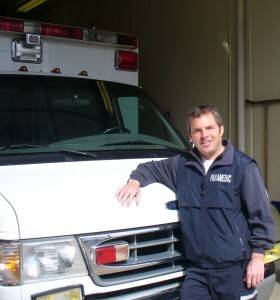When Corey Catt was a child, he was injured farming accident. That accident changed his life and the lives of many others.
“I will never forget the overwhelming feeling of relief when I saw the strong will of the volunteer ambulance members who took time out of their busy day, from their regular day jobs, to help me. Their amazing service sticks with me today as I hope to do the same thing in return by helping those in need,” says Corey Catt, who is an inspiring example of giving back through finding purpose in life and satisfaction in his career.
Corey is in his 25th year as a volunteer paramedic with the Ellsworth (Wisconsin) Ambulance Service. He also has worked part-time as a paramedic in the emergency room at a Regions Hospital Level 1 Trauma Center in St. Paul, Minn., for 11 years. In May, he will celebrate his sixth year as forage products specialist for Latham Hi‑Tech Seeds.
One might wonder how his roles complement each other. As a 911 paramedic, Corey has seen first-hand how nutrition is closely related to human health. As one of the seed industry’s most renowned forage specialists, he helps farmers strike that delicate balance between nature, science and technology. He is passionate about helping farmers produce healthy meat, milk and eggs. It all about people, That’s why he’s spent his career working as both a paramedic and as a forage specialist.
It’s extremely unusual to have a paramedic service in rural communities – especially an advanced life support unit – says Corey. His dream is for every rural community at a minimum, to train its residents in the very simple and basic adult hands-only cardiopulmonary resuscitation (CPR) certification class. Ideally, this would increase the number of people throughout all communities who have the skills necessary to keep someone alive until advanced help can arrive at the scene.
“Science has proven that immediate hands-only CPR on an adult cardiac arrest patient gives that person the best chance of survival. The American Heart Association refers to this as the chain of survival,” says Corey. “Time is so critical after a cardiac arrest. When the heart is not pumping, the brain is not getting oxygen and is dying. Without any CPR within four minutes of arrest, the chance of your friend or loved one surviving is very low.”
It can take more than four minutes for ambulance to reach the patient in rural areas. If there is a snow storm or bad weather, it will take emergency crews even longer. That’s why residents who know CPR can increase someone’s chance of surviving a cardiac arrest.
“I have learned over the years that sometimes you can do more harm by NOT helping someone in need, such as someone having a cardiac arrest. Equipping community members with simple CPR skills can be enough to save a life,” says Corey. “If someone needs CPR and you don’t help them, at a least pray for them. Without you, their chances of survival are slim.”
How You Can Help Your Community
“There is a retired paramedic in a nearby community who was part of a group that started a local hands-only CPR Class. His passion shifted down to his son, who continued expanding his father’s initiative of teaching the simple skills of CPR. One day that retired paramedic was in the gym and had a cardiac arrest in the gym. The gentleman who saved his life was trained in his son’s class the day before! This man’s life was not only changed but saved.”
Corey explains that 4-H clubs, FFA chapters, as well as Boy Scout and Girl Scout troops, are a great place the start. The individuals involved with these groups are the next generation of agriculturists and rural residents. Corey challenges civic groups to team up, so together they can start a community initiative to get more people trained.
Here is what one community has done for hands-only CPR. Some communities have done demo’s at half time basketball games for the whole gym, but at the end of the day, when you see a teen or adult go unconscious, and you can’t wake them up, it takes COURAGE to act. It’s going to be scary.
“At a minimum, learn hands-only CPR. It’s quick, simple and easy to learn. It’s something that could be done every year on farms, in grocery stores and in the gym. You can become part of the chain of survival!” urges Corey.
“It’s impossible to articulate the depths and layers of intensity in the situations people like me experience every single day,” adds Corey, “There’s no doubt it’s a tough profession. I have seen a lot of death and tragedy. You can’t un-see these situations, so I focus on the positive. At the end of the day, it’s about serving people. I’m part of an amazing team that help people navigate through their life-changing event. I feel humbled and honored to somehow serve and help where I can. Not matter what we do, we can all help by knowing hands-only CPR and promoting how this could save a life someday.”
Related Articles:

